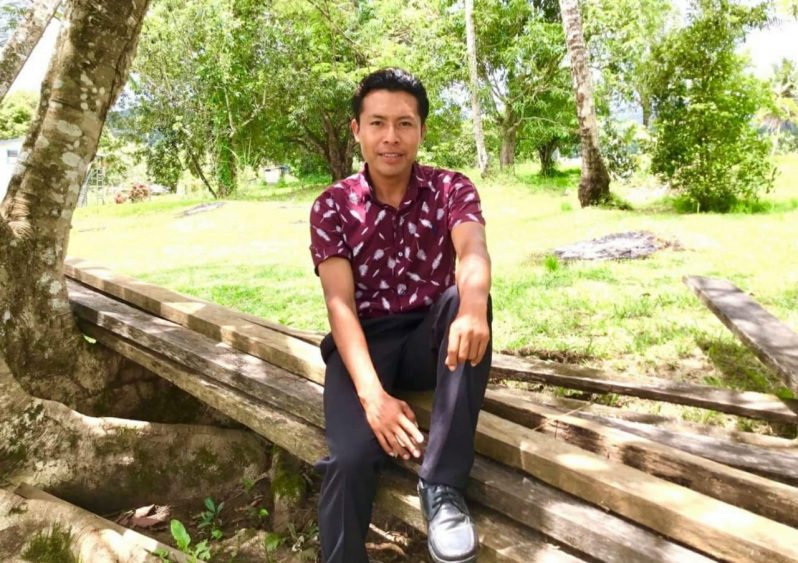By Naomi Parris
AS the curtains falls on this year’s Indigenous Heritage Month celebrations, the Pepperpot Magazine is featuring an up-and-coming videographer/photographer who uses his creative talents to share with Guyana and the rest of the world the unique beauty of the hinterland.
Chris Elliman, who hails from the Arekuna nation of Paruruimo (Paruruyma), like many Amerindian youths, spent most of his childhood days helping his family on the farm or scurrying the forest for adventures.
“During my childhood days I have been engaged in subsistence farming with my parents in order to provide for the family where we usually plant cassava, beans, peanuts, eschallots etc. I still do that to this day because I love and accept the life that we Indigenous people live.”
In 2008, while working as a part-time photographer for the Guyana Elections Commission (GECOM), at the Registration Office in Kamarang, Elliman discovered his love for the art form. Soon after, he started documenting the traditional way of life of his people through photographs.
“I began to see that photography was my interest…I was able to purchase a small camera of my own along with a photo printer and took a lot of family photos as well as photos of my residents. Eventually I tried to compile photos in a video form which attracted some of my people.”
‘A BIG OPPORTUNITY’
 The 32-year-old disclosed that he quickly became known in the Upper Mazaruni area for his talents as he would make various compilations of videos and place them on DVDs to sell, however it was not until 2017 that he saw the strides of his work coming to the forefront when he was presented an opportunity to better his craft.
The 32-year-old disclosed that he quickly became known in the Upper Mazaruni area for his talents as he would make various compilations of videos and place them on DVDs to sell, however it was not until 2017 that he saw the strides of his work coming to the forefront when he was presented an opportunity to better his craft.
“In 2017, the Amerindian Peoples Association (APA) of Guyana saw some of my work and asked if I was interested in doing a Youth Media programme voluntarily. I accepted same and I was joined by other youths from regions one, two, seven, eight and nine….”
The selected individuals took part in several workshops in Georgetown, which among other things taught them how to conduct interviews and video edit.
Elliman was later able to attend a four-day communication and leadership meeting in Quito, the capital city of Ecuador where he met and interacted with other indigenous youths from Colombia, Suriname, Venezuela, Peru, Bolivia, Brazil and the host nation.
“We were encouraged to create videos portraying our way of life and [told] that we should preserve our culture and protect the Amazon at large. This gave me thoughts about my homeland Guyana where we have a lot of nature that we should take good care of, we should preserve our culture as Indigenous Peoples and that’s when I decided to further my skills in creating videos of my village.”
Since this year’s Heritage celebrations were done virtually due to the impacts of the dreaded Covid-19 pandemic, Elliman was able to put his talent to good use. He made a number of videos showing the resilience of the Indigenous people during this time as well as videos of their traditional way of life.
‘SHOWCASING GUYANA’S PEOPLE’
“…I was encouraged by my community members to create short videos that would highlight the activities of the Arekuna Nation. After posting some videos on my Facebook page, a lot of persons became interested in the videos and shared my work,”
He added that, “Indigenous and non-indigenous persons were now becoming aware of my work and started sending a lot of friend request. Currently some persons are following me on social media and have asked me to upload more videos.”
Elliman’s former schoolmates helped him to upload a video of his village entitled ‘Paruima and its Arekuna People’.
He noted that many persons from all parts of the country have reached out to him, sharing how much they have learnt about the Indigenous people who live in hinterland regions through the videos and content he shares.
‘NOT WITHOUT ITS CHALLENGES’
Elliman, who mostly does volunteer work, noted that it can sometimes be tedious for him to make videos and edit them in a timely manner, since he also assist on his family’s farm.
Additionally he noted that with the limited access to finance and without a decent internet connection he is unable to produce more quality videos.
“Probably if finance is available I can manage to do a lot in creating videos, but that is a huge problem for me in my village since I do not have a full-time or part-time job to support my family…also the internet system is not much accessible so posting videos to my organisation or on my page is very difficult.
If the village can be given a free internet system, then it would be easier to communicate via videos and photos with others around the world.”












